Class 9 History Chapter 3 Notes - Nazism and the Rise of Hitler
| Table of contents |

|
| Introduction |

|
| Birth of the Weimar Republic |

|
| Hitler’s Rise to Power |

|
| The Nazi Worldview |

|
| Youth in Nazi Germany |

|
| Difficult Words |

|
Introduction
- In spring 1945, eleven-year-old Helmuth overheard his parents having a serious conversation about the possibility of killing the family or his father committing suicide alone.
- His father, a prominent physician, feared revenge from the Allies, believing they would retaliate as the Germans did to the Jews and the disabled.
- The next day, Helmuth and his father spent their last happy moments in the woods before his father shot himself.
- Helmuth was deeply traumatized by these events and refused to eat at home for nine years, fearing his mother might poison him.
- Helmuth's father was a Nazi and a supporter of Adolf Hitler, who aimed to make Germany a mighty power and conquer Europe.
- Nazism was a structured system of ideas about the world and politics, not just isolated actions.
- In May 1945, Germany surrendered to the Allies after Hitler, Goebbels, and his family committed suicide in April 1945.
 Hitler inspects Nazi troops during a military parade
Hitler inspects Nazi troops during a military parade
Genocidal War
- Nazi Germany's actions led to the mass murder of millions, including around 6 million Jews, 200,000 Gypsies, 1 million Polish civilians, and 70,000 Germans who were viewed as mentally or physically disabled, along with countless political opponents.
- The Nazis created a new method of killing, especially through gassing at extermination camps like Auschwitz.
Nuremberg Tribunal
- The Nuremberg Tribunal was set up to try Nazi war criminals for Crimes against Peace, War Crimes, and Crimes Against Humanity.
- It sentenced only eleven top Nazis to death, while many others received life imprisonment.
- Although some justice was served, the punishments were much less than the scale of their crimes.
- The Allies aimed to be less harsh on the defeated Germany compared to the aftermath of the First World War.
Rise of Nazism
- The rise of Nazi Germany can be partly traced back to Germany's experiences following World War I.
- This time of instability and resentment helped Nazism gain support among the German people.
Birth of the Weimar Republic
- In the early 1900s, Germany was a powerful empire.
- During World War I (1914–1918), Germany fought alongside the Austrian Empire and against countries like England, France, and Russia (the Allies).
- All countries joined the war excitedly, expecting a quick win.
- But the war continued for years and used up a lot of Europe’s resources.
- Germany first gained some areas like France and Belgium.
- In 1917, the USA joined the Allies, which helped them win the war.
- Germany and its partner countries (the Central Powers) were defeated in November 1918.
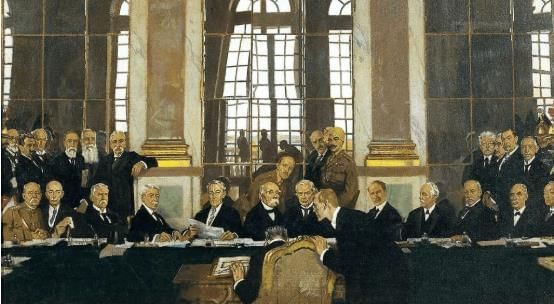 Treaty of Versailles Coming into Effect
Treaty of Versailles Coming into Effect
- After Germany's defeat, the German emperor gave up his throne.
- A new democratic government was formed in the town of Weimar — known as the Weimar Republic.
- A new constitution was made with a federal system.
- All adults, including women, could now vote to choose members of the German Parliament (Reichstag).
Let's Revise: Explain the causes and consequences of the rise of Nazism in Germany after World War I.
 View Answer
View Answer 
Ans: The rise of Nazism in Germany can be attributed to the country’s instability and resentment following its defeat in World War I. The harsh terms of the Treaty of Versailles, including loss of territory, resources, and heavy reparations, created national shame and economic hardship. This environment allowed extremist ideologies like Nazism to gain popular support by promising to restore Germany’s power and pride. Consequently, Nazism led to aggressive policies, ultimately resulting in World War II and the genocide of millions during the Holocaust.
- However, many Germans did not like the new Weimar Republic.
- This was because the peace treaty signed at Versailles after the war was very harsh on Germany.
- Under the Treaty of Versailles:
- Germany lost its overseas colonies.
- It lost 10% of its population and 13% of its land.
- 75% of its iron and 26% of its coal went to countries like France, Poland, Denmark, and Lithuania.
- Germany’s army was reduced to weaken its power.
- The War Guilt Clause blamed Germany for starting the war.
- Germany had to pay £6 billion as punishment.
- The Allies occupied the rich Rhineland area in Germany during the 1920s.
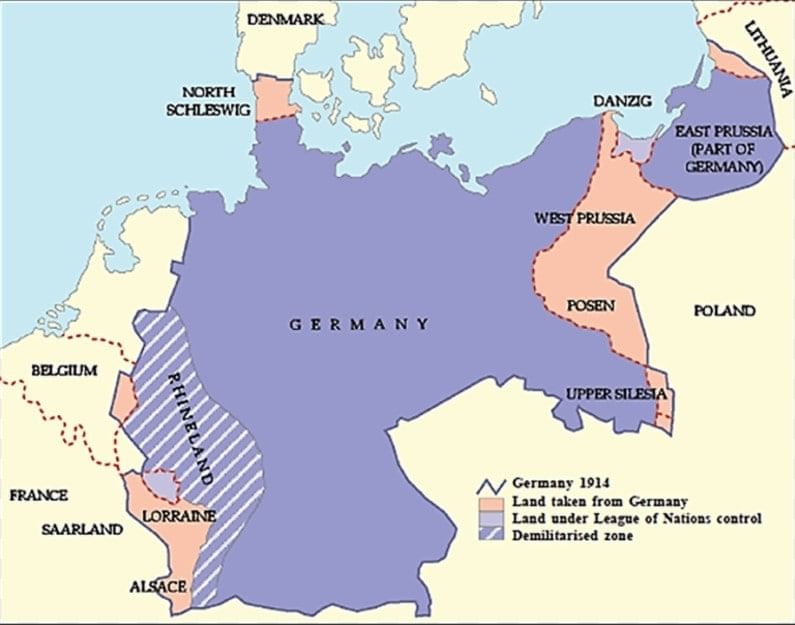 Parts of Territory that Germany lost after the Treaty of Versailles
Parts of Territory that Germany lost after the Treaty of Versailles
- Many Germans blamed the Weimar Republic for Germany’s defeat and the shameful treaty.
The Effects of the War
- The war had a devastating impact on Europe, affecting the continent both psychologically and financially.
- Europe changed from a continent of creditors to one of debtors.
- The young Weimar Republic was made to pay for the mistakes of the old empire.
- The republic bore the weight of war guilt and national humiliation, and was financially crippled by compensation payments.
- Germany lost its overseas colonies, a tenth of its population, 13 percent of its territories, 75 percent of its iron, and 26 percent of its coal to France, Poland, Denmark, and Lithuania.
- The Allied Powers demilitarised Germany to weaken its power.

- Supporters of the Weimar Republic, such as Socialists, Catholics, and Democrats, became easy targets for attacks in conservative nationalist circles.
- They were mockingly called the ‘November criminals’. This hostile attitude influenced political developments in the early 1930s.
- The First World War left a deep mark on European society and politics.
- Soldiers were placed above civilians, with emphasis on men being aggressive, strong, and masculine.
- The media glorified trench life, but the reality was that soldiers lived miserable lives in these trenches.
- They faced rats, poisonous gas, and enemy shelling, witnessing their ranks diminish rapidly.
- After the war, war propaganda and national pride dominated public life.
- Support increased for conservative dictators, while democracy remained unstable in interwar Europe.
Political Radicalism and Economic Crisis
- The Weimar Republic was created in response to the revolutionary uprising by the Spartacist League, which took inspiration from the Bolshevik Revolution in Russia.
- In many cities, Soviets of workers and sailors were set up, and there were calls for Soviet-style governance in Berlin.
- Those opposed to this movement, including Socialists, Democrats, and Catholics, gathered in Weimar to form the democratic republic.
- The Weimar Republic suppressed the uprising with aid from the Free Corps, a group of war veterans.
- In their despair, the Spartacists later established the Communist Party of Germany. This led to a bitter divide, making it impossible for Communists and Socialists to unite against Hitler.
- Political radicalisation increased due to the economic crisis of 1923. Germany had financed much of the war through loans and was required to pay war reparations in gold, which drained its gold reserves.
- When Germany refused to pay in 1923, the French occupied the Ruhr industrial area to seize coal.
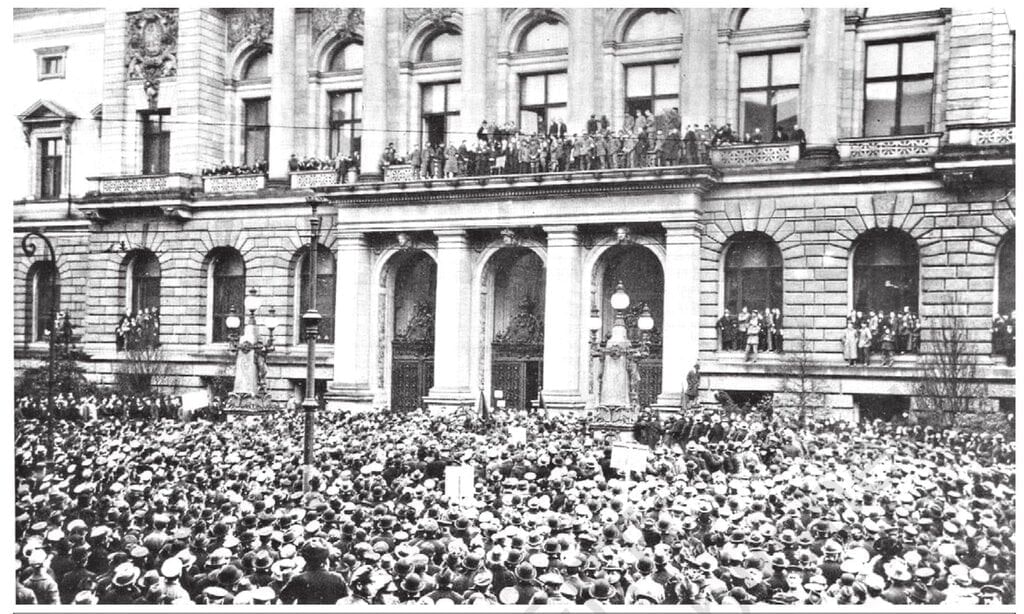 This is a rally organised by the radical group known as the Spartacist League.
This is a rally organised by the radical group known as the Spartacist League.
- In response, Germany resorted to passive resistance and started printing money without restraint, resulting in hyperinflation.
- The value of the German mark plummeted dramatically:
- April 1923: 1 US dollar = 24,000 marks
- July 1923: 1 US dollar = 353,000 marks
- August 1923: 1 US dollar = 4,621,000 marks
- December 1923: 1 US dollar = 98,860,000 marks - This situation gained widespread attention, drawing international sympathy. This period became known as hyperinflation, a time of extreme price increases.
- Ultimately, the Americans intervened and assisted Germany by implementing the Dawes Plan, which revised the reparation terms to alleviate the financial strain on the German people.
Let's Revise: What led to the political radicalism in the Weimar Republic during the early 1920s?
 View Answer
View Answer 
Ans: Political radicalism arose due to the Spartacist uprising inspired by the Russian Bolshevik Revolution and economic crises like hyperinflation. The suppression of the uprising deepened divides, and the economic hardship of reparations and the Ruhr occupation intensified unrest.
The Years of Depression
- The period from 1924 to 1928 brought some stability, but it was built on fragile foundations.
- Germany's investments and industrial recovery relied heavily on short-term loans from the USA. This support vanished after the Wall Street Crash in 1929.
- On 24 October 1929, 13 million shares were sold in a panic, signalling the beginning of the Great Economic Depression.
- Over the next three years, from 1929 to 1932, the national income of the USA halved. Factories closed, exports fell, farmers suffered greatly, and investors pulled their money from the market.
- The repercussions of the US recession were felt globally, with Germany being the most severely affected. By 1932, industrial production in Germany had plummeted to 40% of the 1929 level.
- The unemployment rate soared to an unprecedented 6 million.
- On the streets, men held signs reading, 'Willing to do any work,' while unemployed youths often played cards, loitered in corners, or queued at job centres.
 Sleeping on the line. During the great depression, the unemployed could not hope for either wage or shelter
Sleeping on the line. During the great depression, the unemployed could not hope for either wage or shelter
- As employment opportunities dwindled, some youths turned to crime, and despair became widespread.
- The economic crisis caused fear and stress among people in Germany. Middle-class people, like salaried employees and pensioners, saw their savings lose value due to inflation.
- Many feared becoming poor or unemployed — this fear is called proletarianisation. Organised workers managed slightly better, but unemployment reduced their power to ask for better wages.
- Farmers were badly affected because the prices of crops dropped sharply.
- Women struggled to feed their families, leading to despair and hardship.
- The Weimar Republic was also politically unstable. The constitution had serious flaws that made the government weak.
- One problem was proportional representation, which made it difficult for any one party to win a majority. This led to unstable coalition governments that kept changing.
- Another problem was Article 48, which gave the President the power to rule without Parliament during emergencies. Frequent use of Article 48 and constant government changes made people lose trust in democracy.
- Many felt that the democratic system could not solve Germany’s problems.
Let's Revise: How did the Great Depression impact Germany and its political stability?
 View Answer
View Answer 
Ans: The Great Depression caused massive unemployment, industrial decline, and widespread poverty in Germany. The fragile Weimar Republic, weakened by constitutional flaws and coalition politics, struggled to respond, leading to loss of public faith and increased instability.
Hitler’s Rise to Power
Background of Hitler’s Rise
- The economic, social, and political crisis in Germany helped Hitler rise to power.
- Hitler was born in 1889 in Austria and spent his youth in poverty.
- During World War I, he served in the German army as a messenger, became a corporal, and received medals for bravery.
- Germany’s defeat in the war and the Treaty of Versailles deeply angered him.
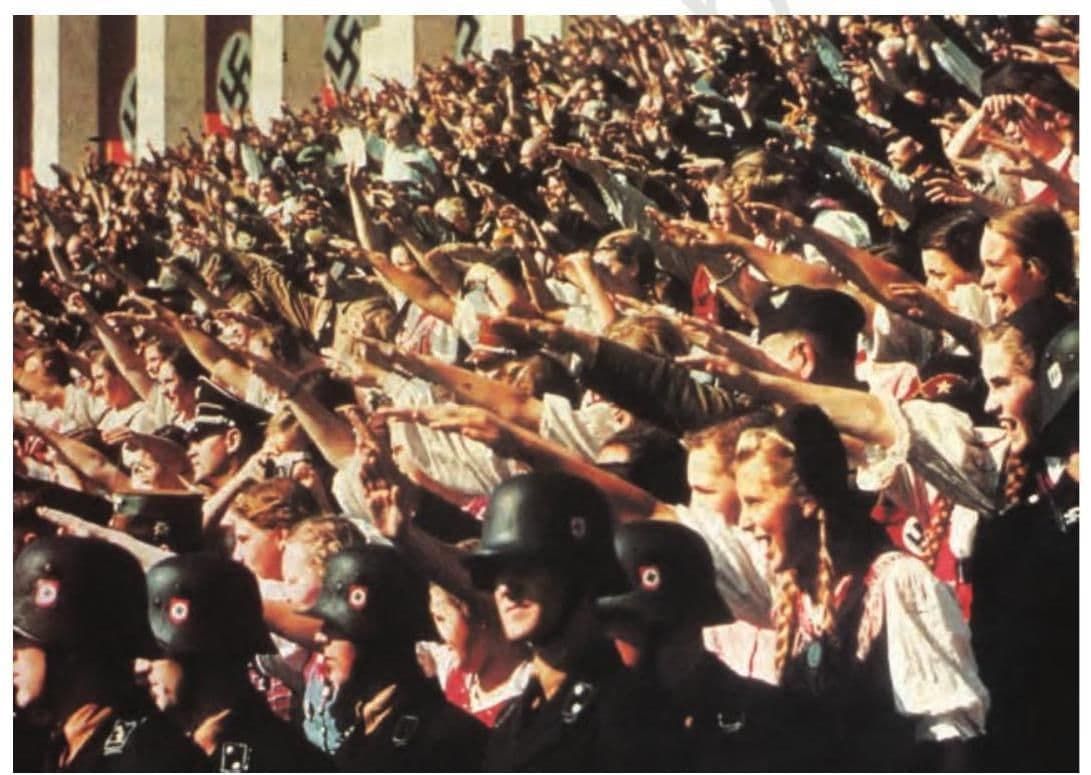 Hitler being greeted at the Party Congress in Nuremberg in 1938.
Hitler being greeted at the Party Congress in Nuremberg in 1938.
Formation of the Nazi Party
- In 1919, Hitler joined a small group called the German Workers’ Party.
- He soon took over the group and renamed it the National Socialist German Workers’ Party (Nazi Party).
- In 1923, he tried to take over the government in Bavaria but failed and was arrested for treason.
- He was later released from jail, but the Nazi Party gained little public support until the early 1930s.
Nazi Growth During the Great Depression
- After the Great Depression began in 1929, German banks collapsed and businesses shut down.
- Unemployment rose, and the middle class faced poverty, making people desperate for change.
- Nazi propaganda gave people hope for a better future.
Hitler’s Rise to Popularity
- In 1928, the Nazi Party got only 2.6% votes in the German Parliament (Reichstag).
- By 1932, it had become the largest party with 37% of the votes.
- Hitler was a powerful speaker who inspired people with his emotional speeches.
- He promised:
- To build a strong Germany
- To cancel the Versailles Treaty
- To give jobs and secure the future of the youth
- To protect Germany from foreign enemies and influences
Nazi Propaganda and Mass Mobilisation
- Hitler introduced a new style of politics focused on rituals, symbols, and public displays of power.
- The Nazis held huge rallies and public meetings to show unity and support.
- Symbols like the red banners with the swastika, Nazi salute, and loud applause after speeches created a strong visual impact.
- Nazi propaganda showed Hitler as a saviour who would rescue Germany from crisis.
- This image appealed to people who had lost their pride and dignity and were suffering due to poverty and instability.
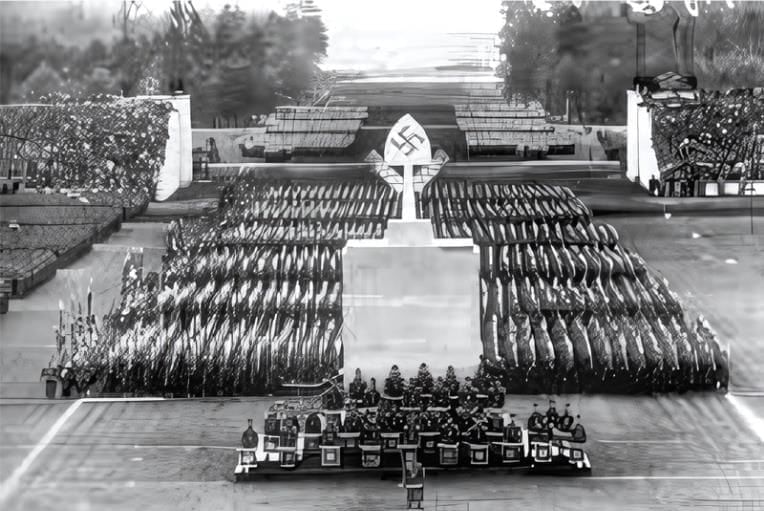 Hitler addressing SA and SS columns.
Hitler addressing SA and SS columns.
Notice the sweeping and straight columns of people. Such photographs were intended to show the grandeur and power of the Nazi movement
Let's Revise: How did Nazi propaganda and political strategy help Hitler gain popular support?
 View Answer
View Answer 
Ans: Nazi propaganda and political strategy helped Hitler gain support by giving people hope during Germany’s crisis. Hitler promised to rebuild the nation, provide jobs, and undo the Treaty of Versailles. Powerful speeches, mass rallies, and symbols like the swastika created unity and pride. Propaganda portrayed Hitler as a saviour, which appealed to people suffering from poverty and instability.
The Destruction of Democracy
- On 30 January 1933, President Hindenburg appointed Hitler as Chancellor, the top role in the cabinet.
- The Nazis had successfully gained support from conservatives.
- After taking power, Hitler began to dismantle democratic structures.
- A mysterious fire in the German Parliament in February helped his cause.
- The Fire Decree of 28 February 1933 suspended civil rights, such as freedom of speech, press, and assembly, which were protected by the Weimar constitution.
- The Weimar Republic experienced instability with twenty different cabinets, averaging just 239 days in office.
- Article 48 was misused, allowing the President to impose emergency powers.
- Hitler targeted his main opponents, the Communists, many of whom were sent to newly formed concentration camps.
- The repression of Communists was intense, with 1,440 of 6,808 arrest files in Duesseldorf alone being for Communists.
- On 3 March 1933, the Enabling Act was passed, establishing a dictatorship in Germany.
- This act allowed Hitler to bypass Parliament and rule by decree.
- All political parties and trade unions were banned except for the Nazi Party.
- The government took control of the economy, media, military, and judiciary.
- New security forces were formed, including:
- Regular police (in green uniform)
- SA (Storm Troopers)
- Gestapo (secret state police)
- SS (protection squads)
- Criminal police
- Security Service (SD) - These forces contributed to the Nazi state's reputation as a feared regime.
- People could be detained, tortured, or arrested without legal procedures.
- The police operated without accountability.
Reconstruction
- Hitler appointed economist Hjalmar Schacht to lead economic recovery.
- This resulted in full production and employment through a state-funded work programme, which included:
- Construction of the German superhighways
- Creation of the Volkswagen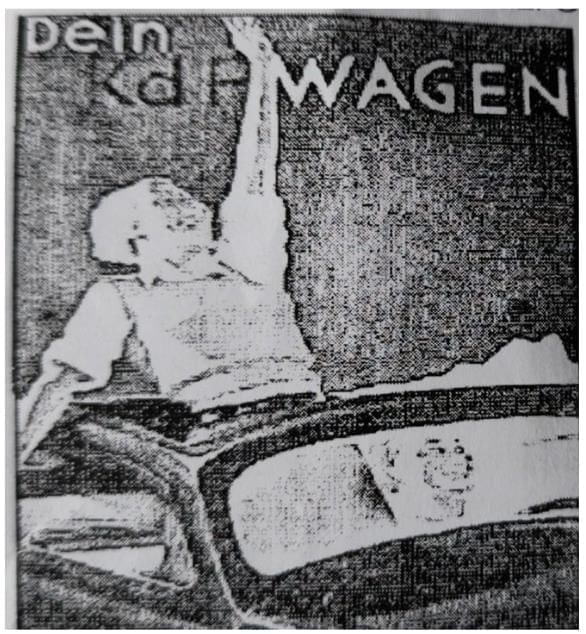 The poster announces: ‘Your volkswagen’
The poster announces: ‘Your volkswagen’ - In foreign policy, Hitler quickly achieved significant milestones:
- Withdrew from the League of Nations in 1933
- Reoccupied the Rhineland in 1936
- Unified Austria and Germany in 1938 under the slogan "One people, One empire, One leader"
- Annexed the German-speaking Sudetenland from Czechoslovakia and later the entire country - Hitler received tacit support from England, which felt the Versailles treaty was too severe.
- Despite Schacht’s warnings against large-scale rearmament, Hitler opted for war to address the economic crisis.
- Puppet regimes loyal to Nazi Germany were set up throughout Europe.
- By the end of 1940, Hitler had reached the peak of his power.
- Hitler wanted to conquer Eastern Europe to get more food and living space for Germans.
- In June 1941, he attacked the Soviet Union — a big mistake. This exposed Germany to British air attacks in the west and strong Soviet forces in the east.
- The Soviet Red Army defeated Germany badly at the Battle of Stalingrad.
- After that, the Soviet Army chased German soldiers back to Berlin.
- This led to Soviet control over Eastern Europe for the next 50 years.
- The USA at first did not want to join the war due to past economic troubles.
- Meanwhile, Japan was growing stronger in Asia and had taken over French Indo-China. Japan planned to attack US naval bases and bombed Pearl Harbor.
- After this, the USA joined the war. The war ended in May 1945:
- Hitler was defeated.
- The USA dropped atomic bombs on Hiroshima (and later Nagasaki) in Japan. - After understanding these events, we return to the story of Helmuth and his father, which shows the brutal crimes committed by the Nazis during the war.
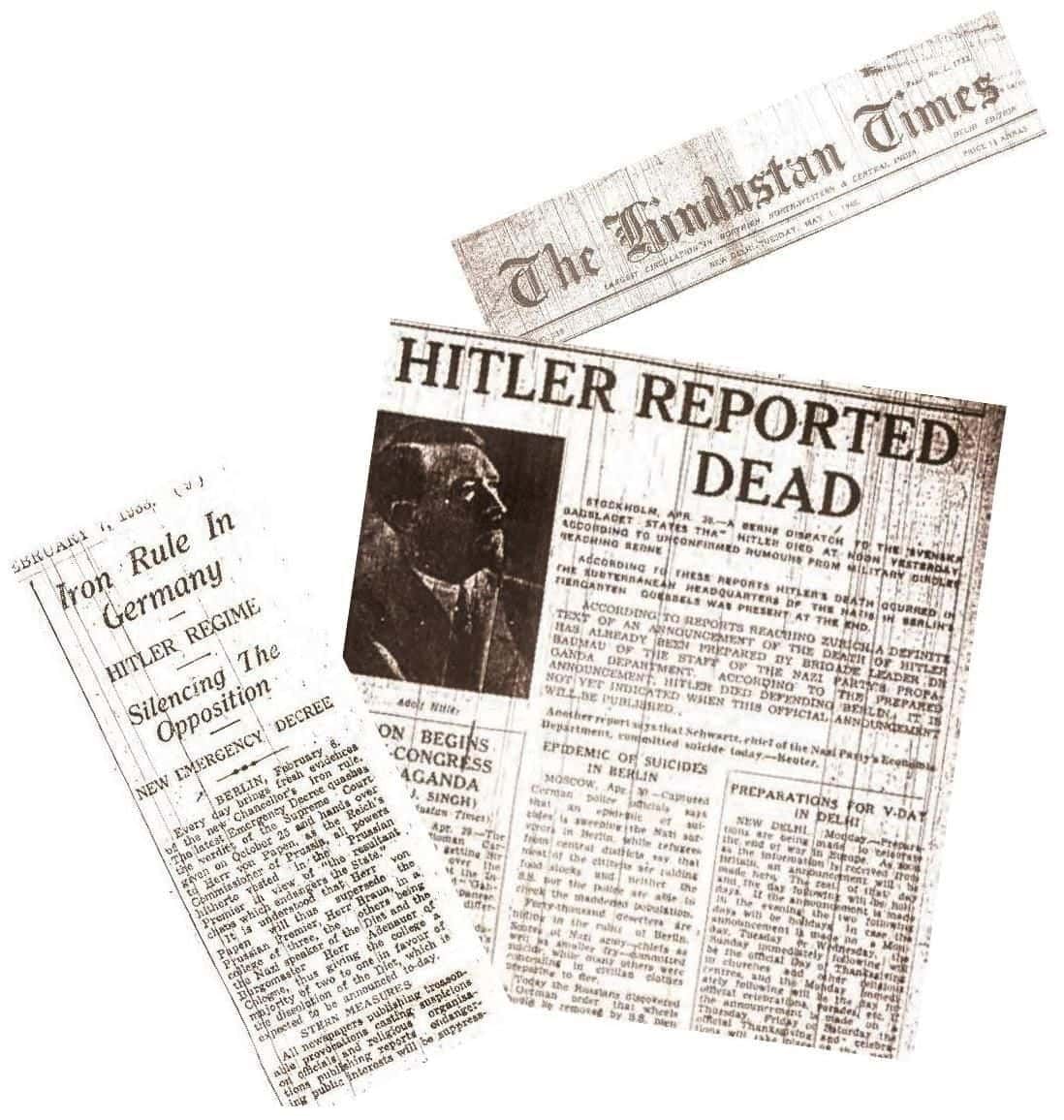 Newspapers in India track the developments in Germany.
Newspapers in India track the developments in Germany.
The Nazi Worldview
Understanding the link between Nazi crimes and their belief system is essential. Hitler's worldview, which shaped Nazi ideology, was based on a strict racial hierarchy. At the top were the blond, blue-eyed Nordic Aryans, who were deemed the superior race. At the bottom of this hierarchy were the Jews, viewed as an anti-race and the main enemies of the Aryans. Other racial groups were ranked in between, based on their physical traits and perceived racial characteristics.
Influence of Darwin and Spencer on Hitler's Racism
- Hitler's racism was shaped by the ideas of Charles Darwin and Herbert Spencer.
- Darwin introduced concepts of evolution and natural selection, explaining the development of living things.
- Spencer contributed the idea of survival of the fittest, suggesting that only adaptable species would thrive.
- Although Darwin did not endorse human intervention in natural selection, his ideas were misused by racist thinkers to justify imperial rule over conquered peoples.
- The Nazis adopted the belief that the strongest race would survive and that weaker races would perish.
- They believed the Aryan race was the strongest and needed to maintain its purity to dominate the world.
Hitler's Concept of Lebensraum
- A significant aspect of Hitler's ideology was the idea of Lebensraum, meaning living space.
- He believed that new territories needed to be acquired for settlement.
- Hitler aimed to expand German borders by moving eastward, viewing Poland as a testing ground for this idea.
- Poland became the laboratory for this experimentation.
- Hitler stated, "The primary right of this world is the right to life, so far as one possesses the strength for this."
Establishment of the Racial State
- After coming to power, the Nazis tried to create a "pure German" society by removing people they thought were "undesirable".
- They wanted only "pure and healthy Nordic Aryans" in Germany and its empire.
- Anyone who was different—like people with mental or physical disabilities—was seen as not fit to live.
- Under the "Euthanasia Programme," even German citizens, like Helmuth’s father, were killed for being mentally or physically unfit.
- The Nazis didn’t only target Jews. Other groups like Gypsies, Black people, Russians, and Poles were also seen as racially inferior.
- These groups were mistreated, forced into hard labour, and many died from overwork and hunger.
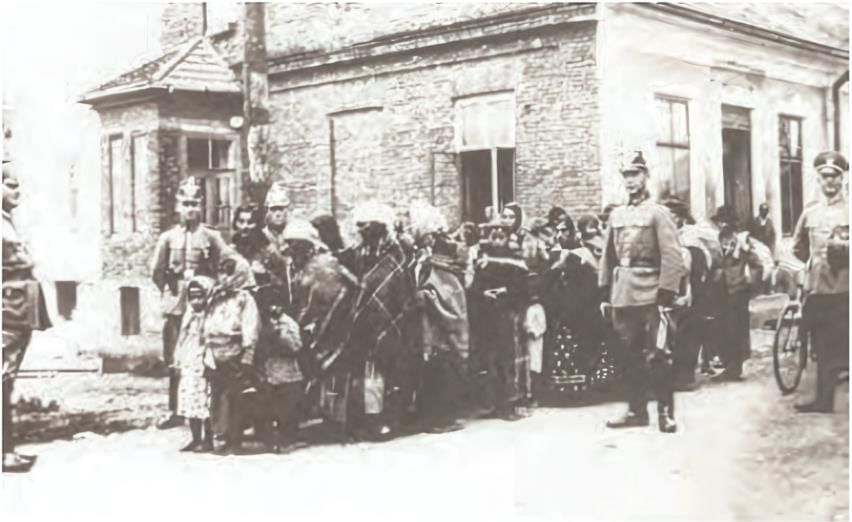 Police escorting gypsies who are being deported to Auschwitz, 1943-1944.
Police escorting gypsies who are being deported to Auschwitz, 1943-1944. Jews were the most targeted group:
- Hatred towards Jews had existed in Europe even before Hitler, especially in Christian beliefs.
- Jews were wrongly blamed for killing Christ and were banned from owning land, so they often worked in trade and moneylending.
- They were forced to live in separate areas called ghettos and were often attacked or forced to leave their homes.Hitler's hatred of Jews was based on false racial science.
- He believed that converting to Christianity would not solve the "Jewish problem".
- He wanted to completely eliminate all Jews.From 1933 to 1938, Nazis:
- Scared and isolated Jews,
- Took away their wealth and rights,
- Forced them to leave Germany.From 1939 to 1945, the plan became more violent:
- Jews were collected into specific areas.
- Many were killed in gas chambers, especially in Poland.
The Racial Utopia
- During the war, Nazis began putting their racist and murderous plans into action.
- Genocide (mass killing) and war went hand in hand under Nazi rule.
- Poland was divided — north-western Poland became part of Germany.
- Polish people were forced to leave their homes, which were given to ethnic Germans.
- Remaining Poles were sent to an area called the General Government, treated badly like animals.
- Educated Polish people were killed in large numbers so that others would not resist Nazi control.
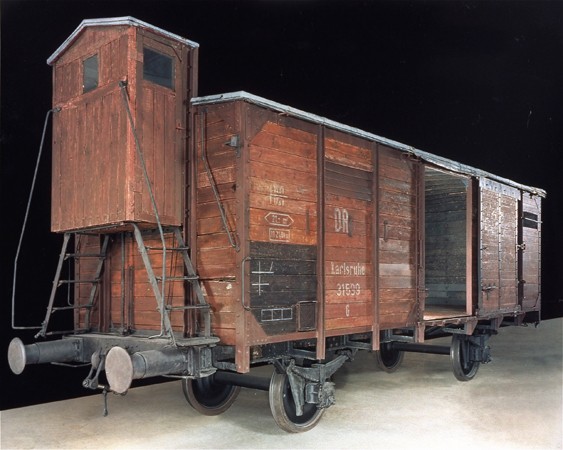 This is one of the freight cars used to deport Jews to the death chambers.
This is one of the freight cars used to deport Jews to the death chambers. - Polish children who looked like Aryans were taken from their families.
- If they passed racial tests, they were raised in German families.
- If not, they were sent to orphanages, where many died.
- The General Government area had huge ghettos and gas chambers where millions of Jews were killed.
Let's Revise
Q: How did Hitler’s racial worldview shape Nazi ideology and policies?
 View Answer
View Answer 
Ans: Hitler’s ideology was based on a racial hierarchy with Nordic Aryans as the superior race and Jews as the main enemies. This led to policies aimed at creating a pure Aryan state by eliminating ‘undesirables’ including Jews, disabled Germans, and other racial groups.
Q: What was the concept of Lebensraum and how did it influence Nazi expansionist policies?
 View Answer
View Answer 
Ans: Lebensraum meant ‘living space,’ and Hitler believed Germany needed to expand eastward to acquire new territories for settlement. Poland was targeted as a testing ground for this policy, which justified conquest and displacement of local populations.
Youth in Nazi Germany
- Hitler aimed to create a powerful Nazi society by teaching children Nazi beliefs both in school and beyond.
- Changes in Schools:
- Schools were 'cleansed' of Jews and teachers who were seen as politically unreliable.
- Children were separated by race; Jews and other 'undesirable' children (such as those who were physically disabled or Gypsies) were expelled.
- Eventually, in the 1940s, these groups were taken to gas chambers.
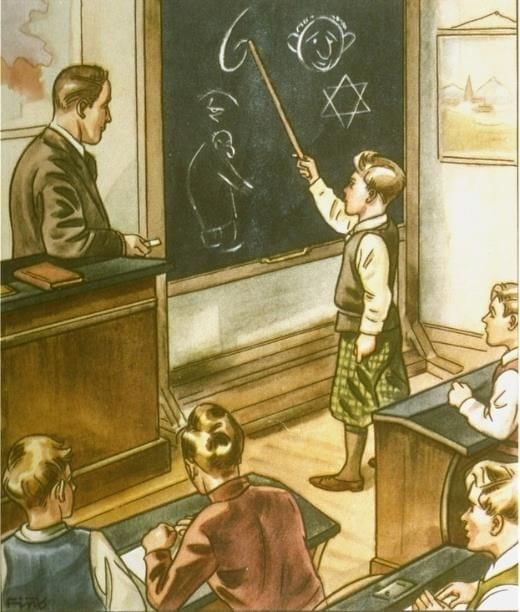 Classroom scene depicting a lesson on racial anti-Semitism.
Classroom scene depicting a lesson on racial anti-Semitism.
- Nazi Schooling:
- Textbooks were rewritten to support Nazi racial ideas.
- Racial science was introduced, promoting negative stereotypes about Jews, even in maths lessons.
- Children were taught to be loyal and obedient, to hate Jews, and to idolise Hitler. Sports were used to instil a sense of violence and aggression; Hitler believed boxing could make children strong and masculine. - Youth Organizations:
- Jungvolk: Boys could join at the age of 10.
- Hitler Youth: Mandatory for boys aged 14; the focus was on glorifying war, aggression, and Nazism while rejecting democracy and those seen as 'undesirable.'
- After training, youths were sent to the Labour Service, military, or Nazi organisations. - Formation and Control:
- The Nazi Youth League was established in 1922 and was renamed Hitler Youth four years later.
- All other youth organisations were systematically dissolved and banned to ensure control was consolidated.
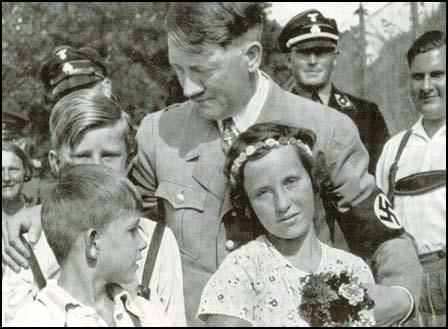 Desirable Children that Hitler wanted to see multiplied
Desirable Children that Hitler wanted to see multiplied
The Nazi Cult of Motherhood
- In Nazi Germany, children were taught that women were fundamentally different from men.
- The movement for equality between men and women was seen as a threat to society.
- Boys were trained to be strong, masculine, and unemotional.
- Girls were taught to be dedicated mothers responsible for raising pure-blooded Aryan children.
- Women were expected to maintain racial purity, avoid contact with Jews, and pass on Nazi values to their children.
- Hitler stated in 1933, "In my state the mother is the most important citizen."
- However, not all mothers received equal treatment in Nazi Germany.
- Women who had racially undesirable children faced penalties, while those with racially desirable children were rewarded. Rewards included:
- Preferential treatment in hospitals.
- Concessions in shops.
- Discounts on theatre tickets and railway fares. - To encourage higher birth rates, the Honour Crosses were introduced:
- A bronze cross for four children.
- A silver cross for six children.
- A gold cross for eight or more children. - Aryan women who did not follow Nazi rules faced public shame and harsh punishments. Those who associated with Jews, Poles, or Russians were publicly humiliated:
- Paraded through towns with shaved heads and blackened faces.
- Held placards saying, "I have sullied the honour of the nation." - Many faced jail time and lost their social standing, including their families, for this 'criminal offence.'
The Art of Propaganda
- Nazis used euphemisms for mass killings, calling them special treatment, final solution (for Jews), euthanasia (for the disabled), selection, and disinfection.
- 'Evacuation' referred to deportations to gas chambers.
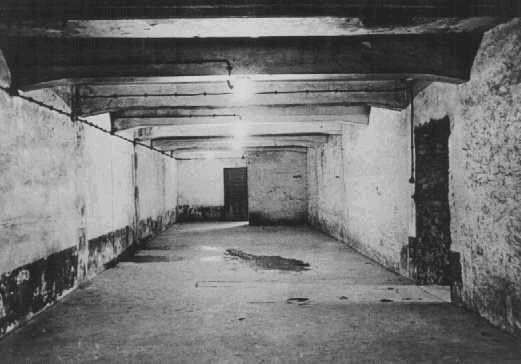 Gas Chamber
Gas Chamber
- Gas chambers were disguised as 'disinfection areas' and made to look like bathrooms with fake showerheads.
- Nazi ideas spread through various media:
- Visual images.
- Films.
- Radio broadcasts.
- Posters.
- Catchy slogans and leaflets. - Propaganda films, like The Eternal Jew, aimed to create hatred towards Jews.
- Orthodox Jews were often portrayed as vermin, rats, and pests in these materials.
- The Nazis targeted specific groups in their propaganda, claiming they alone could fix the issues facing Germany.
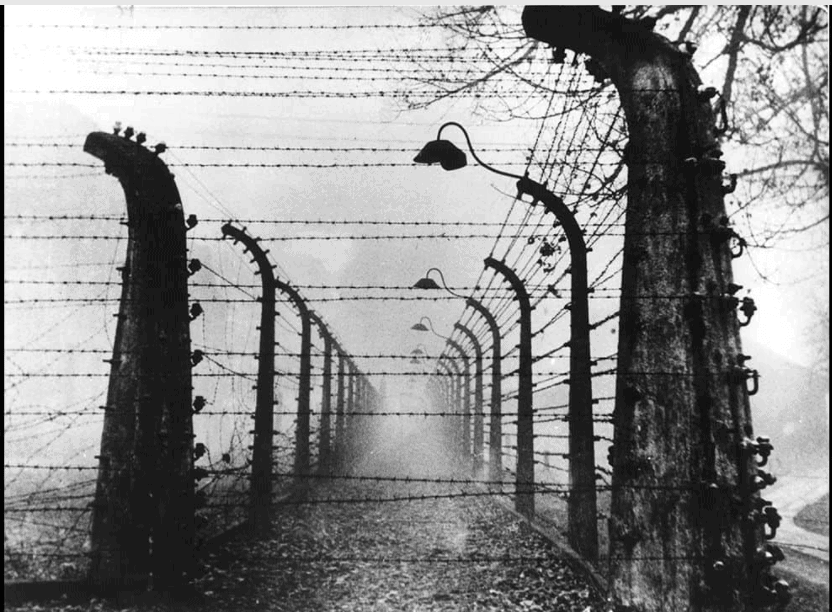 A Concentration Camp
A Concentration Camp
Ordinary People and the Crimes Against Humanity
People's responses to Nazism in Germany varied widely:
- Many Germans accepted Nazi beliefs, adopting its language and ideas. They expressed hatred towards Jews, marked their homes, and reported neighbours they considered suspicious, genuinely believing that Nazism would lead to prosperity.
- Some organised active resistance against Nazism, risking police repression and death.
- However, most Germans remained passive observers, choosing to ignore the situation. They were often too afraid to act, protest, or stand out. Pastor Niemoeller, a resistance fighter, noted this silence in the face of Nazi crimes, regretting that people did not speak out until it was too late.
- The lack of resistance was not only due to fear. As Erna Kranz, a German who lived through the 1930s, pointed out, many people welcomed the apparent economic recovery under the Nazis, feeling downtrodden.
- In Nazi Germany, Jews suffered many forms of death even before reaching the gas chambers. The psychological torment began long before many were sent to their deaths, causing them to endure repeated suffering.

Knowledge about the Holocaust
- During the last years of Nazi rule, some information about their cruel actions started to spread outside Germany.
- But the real horrors were known only after Germany was defeated in World War II.
- The Germans were mainly focused on rebuilding their country after the war.
- But the Jews wanted the world to remember their suffering during the Nazi killings (known as the Holocaust).
- In ghettos (Jewish areas), some people wished to survive the war just to be able to tell others what happened.
- Many people in camps and ghettos wrote diaries, kept notes, and saved documents to record their painful experiences.
- When the war was about to be lost, Nazi leaders tried to destroy all evidence by giving petrol to their workers to burn official records.
- Even today, the memory of the Holocaust is kept alive through stories, movies, poems, museums, and memorials.
These works are:
- A tribute to those who fought back
- A shameful reminder to those who helped the Nazis
- A warning to those who stayed silent during the cruelty.
Difficult Words
- Weimar Republic: The democratic government founded in Germany following the abdication of Emperor Wilhelm II in 1918, which lasted until 1933 when the Nazis came to power.
- Treaty of Versailles: The peace treaty that ended World War I between Germany and the Allied Powers, which imposed heavy reparations and territorial losses on Germany.
- War Guilt Clause: Article 231 of the Treaty of Versailles, which assigned blame for World War I solely to Germany and its allies, making them responsible for all damages.
- Hyperinflation: A very high and typically accelerating rate of inflation, often exceeding 50% per month, leading to the rapid erosion of the real value of local currency, as the prices of all goods increase.
- Proportional Representation: An electoral system in which parties gain seats in proportion to the number of votes cast for them.
- Article 48: A clause in the Weimar Constitution that allowed the President, under certain circumstances, to take emergency measures without the prior consent of the Reichstag.
- Chancellorship: The position of the Chancellor, a senior official (often the prime minister) in some countries, responsible for leading the executive branch and the government.
- Enabling Act: A 1933 Weimar Constitution amendment that gave the German Cabinet — in effect, Chancellor Adolf Hitler — the power to enact laws without the involvement of the Reichstag.
- Euthanasia Programme: A program during Nazi Germany aiming at the systematic killing of the mentally and physically disabled and sick, considered by the Nazis as "life unworthy of life."
- Lebensraum: A Nazi policy and ideology of territorial expansion, based on the notion of natural rights to land believed necessary for national survival and growth.
- Racial Hygiene: The set of eugenic policies embraced by the Nazis to "improve" the genetic quality of a race, primarily aimed at increasing the reproduction of characteristics deemed desirable.
- Genocide: The intentional action to destroy a people—usually defined as an ethnic, national, racial, or religious group—in whole or in part.
- Orthodox Jews: Adherents to a traditional form of Judaism which strictly observes religious laws and practices.
- Propaganda: Information, especially of a biased or misleading nature, used to promote a political cause or point of view.
- Holocaust: The genocide of six million Jews and the persecution and murder of other minority and dissenting groups by the Nazis during World War II.
- Concentration camp: A camp where people were isolated and detained without due process of law. Typically, it was surrounded by electrified barbed wire fences.
- Proletarianisation: To become impoverished to the level of working classes.
- Nordic German Aryans: One branch of those classified as Aryans. They lived in north European countries and had German or related origin
- Gypsy: The groups that were classified as ‘gypsy’ had their own community identity. Sinti and Roma were two such communities. Many of them traced their origin to India.
- Pauperised: Reduce to absolute poverty
- Persecution: Systematic, organised punishment of those belonging to a group or religion
- Usurers: Moneylenders charging excessive interest; often used as a term of abuse
- Jungvolk: Nazi youth groups for children below 14 years of age.
Some important dates
- August 1, 1914: First World War begins.
- November 9, 1918: Germany capitulates, ending the war.
- November 9, 1918: Proclamation of the Weimar Republic.
- June 28, 1919: Treaty of Versailles.
- January 30, 1933: Hitler becomes Chancellor of Germany.
- September 1, 1939: Germany invades Poland. Beginning of the Second World War.
- June 22, 1941: Germany invades the USSR.
- June 23, 1941: Mass murder of the Jews begins.
- December 8, 1941: The United States joins Second World War.
- January 27, 1945: Soviet troops liberate Auschwitz.
- May 8, 1945: Allied victory in Europe.
|
55 videos|525 docs|78 tests
|
FAQs on Class 9 History Chapter 3 Notes - Nazism and the Rise of Hitler
| 1. What were the main effects of World War I on Germany that contributed to the rise of Nazism? |  |
| 2. How did Adolf Hitler rise to power in Germany? |  |
| 3. What role did propaganda play in the Nazi regime? |  |
| 4. What were the social impacts of Nazism on German society? |  |
| 5. How did the Nazi regime's policies lead to World War II? |  |
















